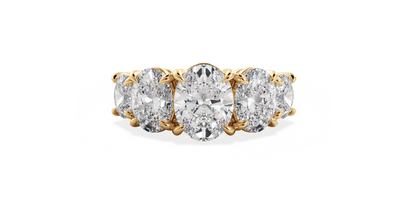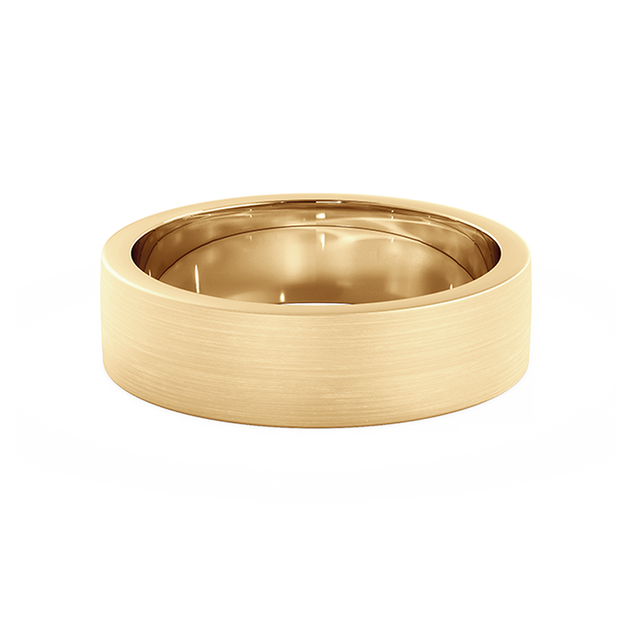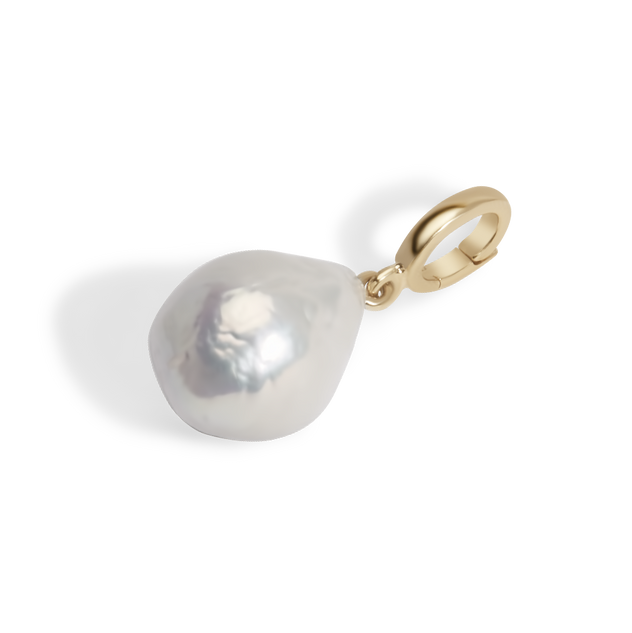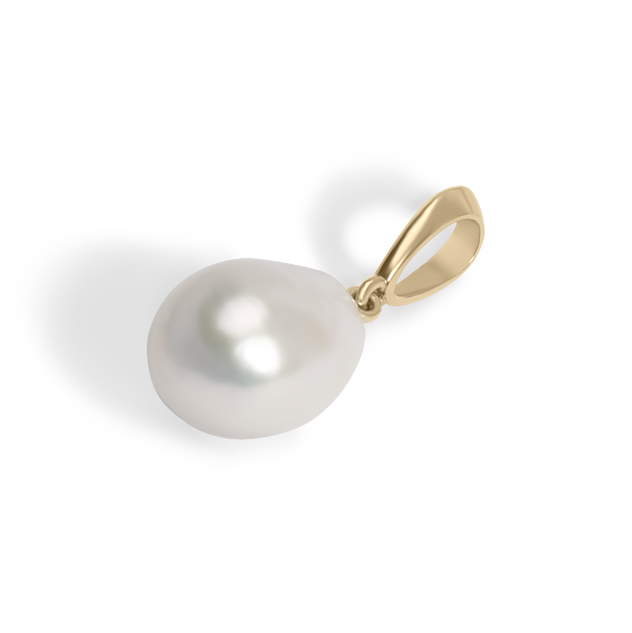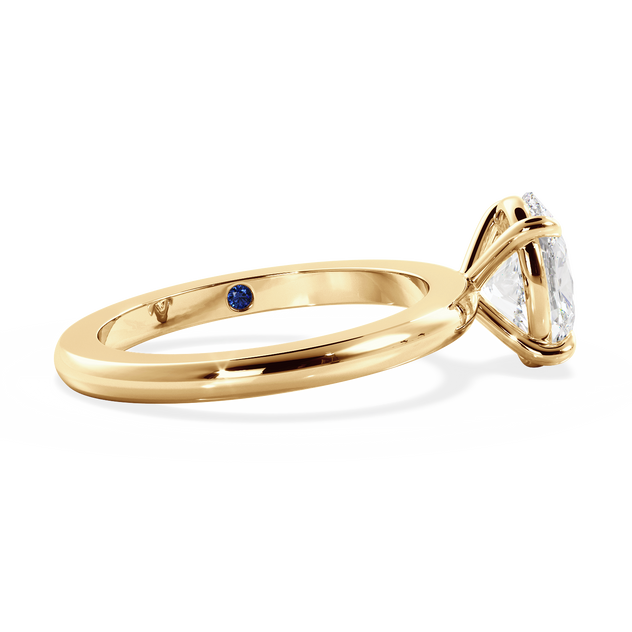Use an existing ring that fits on the ring finger
Cushion shaped diamonds are some of the oldest, most traditional diamond cuts and more recently have had one of the biggest modern resurgences. With varied shapes, ratios and cutting styles, they are some of our most sought after diamond shapes.
Cushion shapes were born from the ‘Mine Cut’ diamonds of Brazil from the 19th century, which featured a square shape with rounded corners and soft edges, resembling a cushion. As diamond cutting techniques around the world progressed, cuts such as the ‘Old Mine Cut’, candlelight and Peruzzi cut all evolved with unique faceting patterns.
Today modern cushions vary in their faceting pattern, but often offer a brilliant style sparkle with maximum brilliance and fire. While the square cushion is a timeless classic, the elongated cushion is quickly becoming one of the most loved diamond shapes for Louise Jean clients.
Cushion Diamond Ratio
The carat of a diamond is a unit of measurement relating to how much it weighs. Carat does not directly correlate with the visual size, and therefore each diamond will be unique in terms of its dimensions and proportions, this is referred to as the diamond’s ratio.
The ratio is calculated by dividing the length of the diamond by the width. A square cushion has a ratio of 1.00 - it is the same length and width. Elongated cushions are generally considered those with a ratio over 1.10, but we tend to look for those from around 1.20.
A lower ratio equates to a wider, plumper cushion, and a higher ratio reveals a narrower, elongated shape. Ratio is truly a matter of personal preference but is something you may like to pay attention to when considering a diamond’s dimensions.

Above: Cushion diamond ratios by scale

Above: Cushion diamond carats and ratios to scale (left) and (right) a 1.95ct elongated cushion solitaire (top) and a 1.5ct square cushion solitaire (below).
Cushion Diamond Cut
A diamond’s cut is the most important factor that affects how visually beautiful the diamond is to look at - that is, how the diamond cutter has taken a diamond rough, and shaped all of the angles and facets of the diamond to create the beautiful stones that we see today. In particular, the depth, angles and faceting of a diamond will determine how well it reflects the light that enters it, and therefore how it sparkles!
For all elongated diamond shapes, including elongated cushions, a natural part of this is the presence of a bow-tie effect through the middle of the stone. This is where the angled facets may not absorb or reflect the light most effectively, resulting in dark or dull patches, also known as light leakage.
All elongated cushion diamonds will have some presence of a bow tie - a critical factor that we consider when sourcing our diamonds is to ensure that the bow-tie is not the first thing that your eye is drawn to. This is not something that is determined by the certificate alone but must be assessed visually.
Unlike round diamonds, fancy shaped diamonds such as cushions do not have a universal cut grading. While your diamond certificate may indicate the Polish or Symmetry of the stone, these can be varied based on a variety of factors and cannot be considered definitive. There are no set rules on how each cushion diamond should be cut. This means that there is no magic formula for their proportions - but there are specific characteristics that can contribute to a more beautiful stone.
In this way, the cut grading of a cushion diamond on the certificate is not the best indication of how beautiful a diamond may be to look at. It is important to look far beyond the grading on a certificate but to assess the stone itself visually. This allows us to assess the light interaction, sparkle and brilliance, and visual beauty of the stone.
You may also like to consider the characteristics of your cushion's shape. For example, some have quite straight edges with soft, rounded corners. Others have a gentle curvature of their edges, but slightly pointed corners.

Above: A cushion diamond with straight edges (left) and a cushion diamond with curved edges (right).
Most cushions today have a modified brilliant cutting style, which display smaller facets and result in unrivalled sparkle.
Antique and Old-Mine diamonds still exist in the market, as well as modern diamonds that have been cut with inspiration from the old-cut faceting style.

Above: 1.51ct Elongated Cushion Ceremonial Solitaire and Fluir Ring (left) 2.52ct Elongated Cushion Ceremonial Solitaire (right)
Cushion Diamond Colour
Different diamond shapes will also call for different standards of grading characteristics. Some diamonds can hide colour better than others.
Brilliant cut diamonds such as cushions can tend to show their colour more visibly - if you are interested in a coloured diamond such as a yellow diamond, they can be particularly beautiful and more abundant shapes for this reason.
When it comes to white diamonds, at Louise Jean we source cushion shapes between a D and G colour grading as a minimum. Diamonds graded D-F are considered colourless, and G is near-colourless. This ensures a bright and sparkly stone, with no visible colour. To the untrained eye, there is generally very little visual difference between a D and a G, but there can be a significant price difference.
G-H coloured diamonds can present good value in terms of price, but it is important to note that not all diamonds are created equal, and there can be ‘grades within grades’. This is another area where we look beyond the diamond certificate and carefully consider the visual appearance of the diamond itself. Many of these near-colourless diamonds have undesirable undertones of yellow or grey and are avoided.
Smaller diamonds or those with lower carat weights can hide colour better than larger stones. For this reason, for lower carat weight diamonds you may opt for a lower colour grading. Diamonds above 1.50ct typically expose colour in lower grades more predominantly.

Above: A compass set 1ct Cushion Classic Solitaire (left) and a 1.42ct Elongated Old Mine Cushion Classic Solitaire (right).
Cushion Diamond Clarity
Clarity is an assessment of the natural imperfections - known as inclusions and blemishes - present in a diamond. There are many different types of inclusions, but these can be dark spots or marks which affect the visual beauty of your stone.
We will consider a wide range of clarity gradings, from Internally Flawless (IF) - SI1. The faceting of modern brilliant cushion cut diamonds means that their sparkle often helps to mask inclusions in ‘smart’ locations throughout the diamond. In this way, SI1 or SI2 diamonds can be beautiful and present excellent value in some cases.
For us, the priority is that no matter the clarity grading on paper, we always guarantee that our diamonds will be eye-clean of any inclusions. That is, there will be no imperfections visible unless looking under magnification. This can only be assessed by looking at the diamond itself - either in person, or in detailed imagery such as a 360-degree video.
While we will always help to prioritise your own preferences, we don’t source Flawless diamonds, and very rarely Internally Flawless. These carry an enormous premium, purely for the words on the certificate that have no effect on how the diamond actually looks to the eye.
Clarity is often mistaken for the diamond cut. As long as your diamond is eye clean, the clarity grading will have no effect on the visual beauty of a diamond, and different clarity gradings cannot be told apart. A carefully considered clarity grading is often one of the best ways to get value from your diamond, allowing you to prioritise cut, carat or colour.
Cushion Diamond Carat
There are no rules when it comes to the best diamond size, and no such thing as the ‘most-popular’.
Diamond size is truly a personal preference, and may depend on many factors. This can include the proportions of your own hand, so we recommend trying different diamond sizes to get a feel for what stands out to you.
We certainly don’t believe that bigger is always better, but that this should be a decision that feels like the right fit for the aesthetic that you are envisioning, your lifestyle, and your ideal budget range.
Don’t forget that carat itself is only a measurement of the weight of a diamond - if you are most concerned about the appearance of size, it’s important to pay attention to the dimensions of each stone.
This can be quite different from shape to shape, even amongst square and elongated cushions. The nature of cushion shapes means they are often deeper in comparison to other diamond shapes, so they may not appear as large on the finger as an equivalent carat weight in another shape.

Above: Loose cushion cut diamond (left) and 2.08ct Cushion Classic Solitaire (right).
